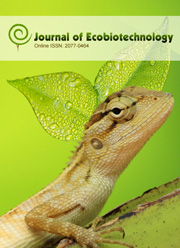Analysis of antioxidant enzyme activity during reproductive stages of barley under drought stress
Keywords:
Hordeum Vulgare, Drought, Reproductive stages, Antioxidant enzymes, Lipid peroxidationAbstract
Drought is especially considered as key stress factor with high potential impact on crop yield. Plants mainly adapt to water deficits by alteration in physiological and biochemical processes. A simulation experiment on the responses of barley (Hordeum Vulgare L.) from heading stage to ripening stage for different soil water levels (full water supply, light water stress, and severe water stress) was conducted to determine the effects on leaf water status, levels of chlorophyll and protein, lipid peroxidation and antioxidant enzymes activity. The results indicated that drought stress relied on drought intensity and developmental stage, with more severe drought stress creating more serious effects on barley. Relative water content (RWC) significantly decreased (P < 0.05) under drought stress in all stages. The content of soluble protein and chlorophyll decreased and membrane lipid peroxidation (measured as malondialdehyde content) increased significantly according to the severity of water stress and reproductive stage. Under water stress, the activities of antioxidant enzymes ascorbate peroxidase (APX), catalase (CAT), guaiacol peroxidase (POX) and superoxide dismutase (SOD) in leaves increased sharply in flowering and milking stages, but then declined towards the lately ripening stage. Furthermore, compared with well watered conditions, changes in the activities of POX and SOD were different between light water stress and severe water stress at flowering and milking stages. However, the increases in the levels of malondialdehyde (MDA) during flowering and milking stages showed that the increased activities of antioxidant enzymes may not be enough to prevent the peroxidation of lipid membranes and to scavenge reactive oxygen species (ROS) under drought stress.



 .
.